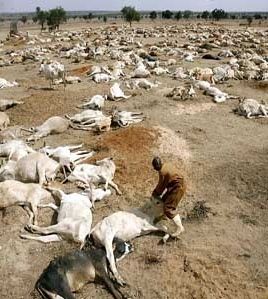The Economics of Climate Change in Kenya


Effects of drought in Kenya: Image: © Newstime Africa
Executive Summary
This study has assessed the Economics of Climate Change in Kenya. It was funded by DFID and DANIDA and undertaken by the Stockholm Environment Institute (in Oxford) working with local partners. It covers: 1. The impacts and economics costs of climate change; 2. The costs of adaptation;3. The potential for low carbon growth.
The study advances a number of approaches to investigate these areas, using aggregated analysis (top-down), sector assessment (bottom-up) and case studies. The key messages are presented below.
The Economic Costs of Climate Change Impacts in Kenya
The first key finding is that existing climate variability has significant economic costs in Kenya.
- Periodic floods and droughts (extreme events) already cause major socio-economic impacts and reduce economic growth in Kenya. Recent major droughts occurred in 1998-2000, 2004/05 and in 2009. Major floods occurred in 1997/98 and 2006.
- The economic costs of droughts affect the whole economy. The 1998-2000 event was estimated to have economic costs of $2.8 billion from the loss of crops and livestock, forest fires, damage to fisheries, reduced hydro-power generation, reduced industrial production and reduced water supply. The 2004 and 2005 droughts affected millions of people and the recent 2009 drought has led to major economic costs from restrictions on water and energy.
- The 1997/98 floods affected almost 1 million people and were estimated to have total economic costs of $0.8 to $1.2 billion arising from damage to infrastructure (roads buildings and communications), public health effects (including fatalities) and loss of crops. The more recent 2006 event affected over 723,000 people in Kenya.
- The continued annual burden of these events leads to large economic costs (possibly as much as $0.5 billion per year, equivalent to around 2 % of GDP) and reduces long-term growth. There is some indication that there has been an intensification of these extreme events over recent decades and these may reflect a changing climate already. However, these impacts also have to be seen in the context of changing patterns of vulnerability, for example from changing land–use patterns, rising populations, etc. Nonetheless, a key finding is that Kenya it is not adequately adapted to deal with existing climate risks.
The second key finding is that future climate change will lead to additional and potentially very large economic costs.
- Africa is predicted to have greater impacts than other world regions, because of higher vulnerability and lower adaptive capacity. Impacts could threaten past development gains and constrain future economic progress. Some regions and populations in Kenya have very high vulnerability. The study has investigated these effects using a number of different approaches.
Top down aggregated estimates
- The study has undertaken top-down aggregated assessments of the economic costs of climate change using global models. These future economic costs are very uncertain. However, aggregate models indicate that the additional net economic costs (on top of the costs of existing climate variability) could be equivalent to a loss of 2.6% of GDP each year 1 by 2030 in Kenya.
- In the longer-term, after 2050, the economic cost of climate change in Africa and Kenya is expected to rise, potentially very significantly. However, the aggregate models report that global stabilisation scenarios towards a 2ºC target could avoid the most severe social and economic consequences of these longer-term changes. This emphasises the need for global mitigation.
Sector (bottom up) assessments
- The study has also undertaken bottom-up assessments of the impacts and economic costs of climate change for a number of sectors, using climate and socio-economic projections.
- Kenya already has a complex existing climate, with wide variations across the country and very strong seasonality. It has two wet seasons and has strong patterns of climate variability and extremes, not least due to the periodic effects from ENSO: El Niño and La Niña, which are associated with extreme rainfall and flooding and droughts (respectively).
-
The study has considered projections of future climate change from a suite of downscaled global models for Kenya, such as:
-
Temperature. The projections indicate future increases in mean annual temperature (average monthly temperatures) of broadly 1 to 3.5 ºC over the range of models by the 2050s (2046 -2065). There will also be increases in sea level.
-
Rainfall. The changes in precipitation are more uncertain. All the climate models show that rainfall regimes will change but these vary with season and region. Most models project rainfall will increase on average, though some models project rainfall reductions in some months for some areas.
-
Extreme events. The information on extreme events (floods and droughts) is much more variable and future projections vary widely. Many models indicate an intensification of heavy rainfall in the wet seasons, particularly in some regions and thus greater flood risks. Droughts are likely to continue but the projections are more varied – some models project an intensification of these events, particularly in some regions, though other models indicate reductions in severity.
- The range of model results highlights the considerable uncertainty in predicting future effects, especially in relation to scenarios of future rainfall, floods and droughts, though also due to future socio-economic conditions and environmental services. Nevertheless, the analysis here does reveal potential areas of concern and helps focus priorities. Furthermore, it is essential to recognise this uncertainty, not to ignore it. There is a need to plan robust strategies to prepare for uncertain futures, rather than using uncertainty as a reason for inaction.
Suggested citation
Stockholm Environment Institute (2009) The Economics of Climate Change in Kenya: Final Report submitted in advance of COP15. Stockholm Environment Institute, Stockholm, Sweden 65 pp.
(0) Comments
There is no content